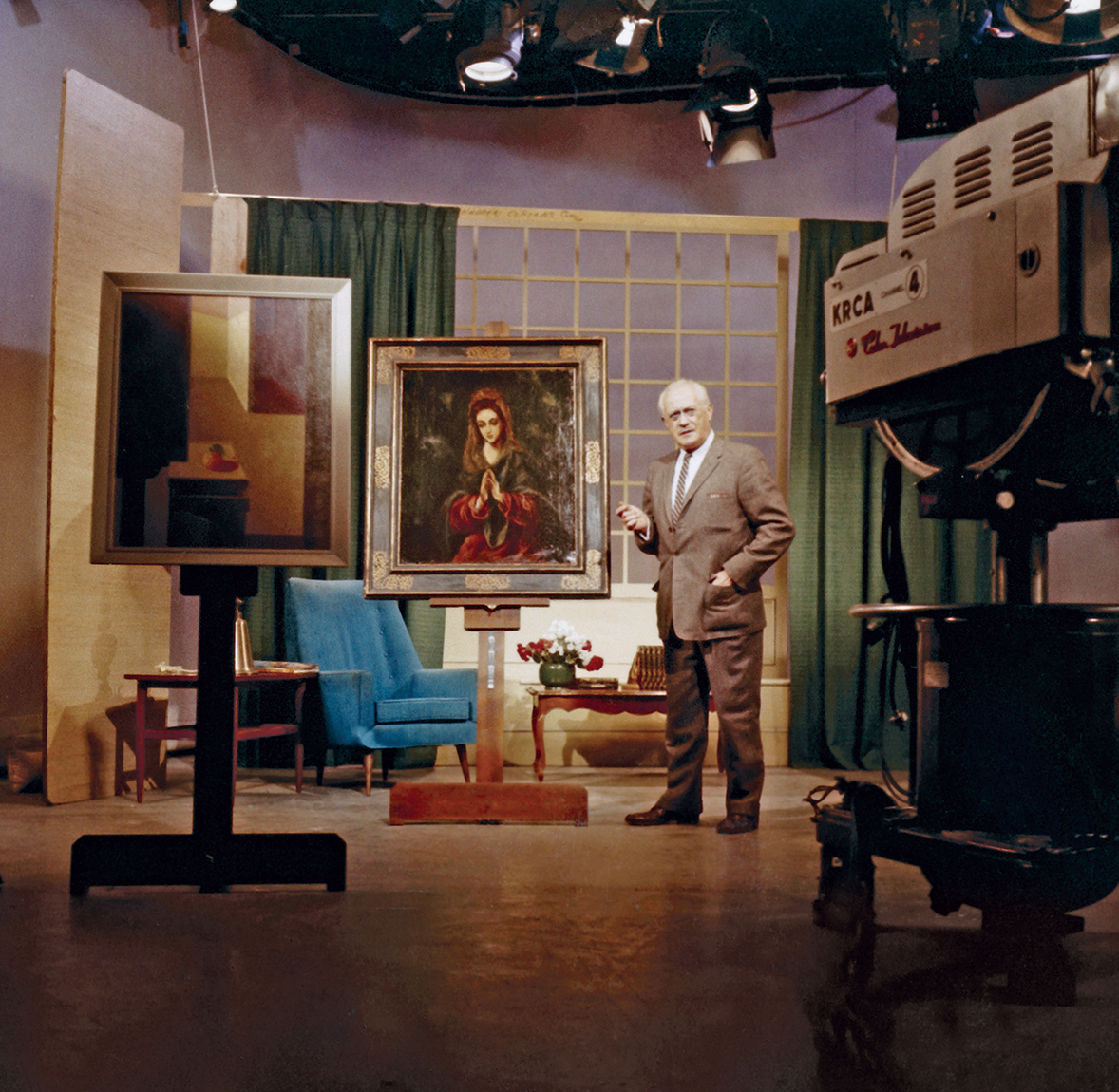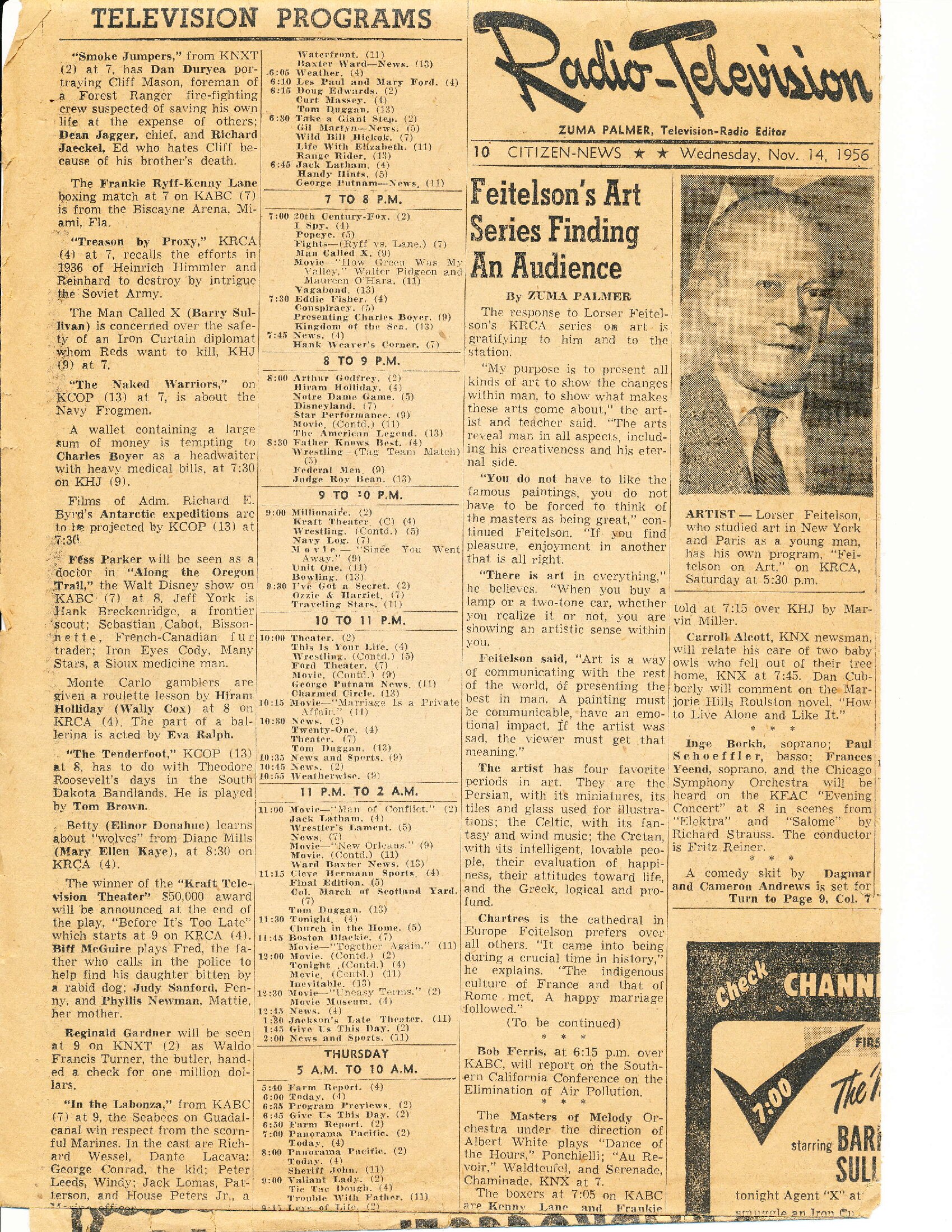Feitelson on Art
Harry Carmean shared memories of helping Feitelson behind the scenes of the nationally-syndicated television show, Feitelson on Art. - Wendy Van Haerlem
unidentified photographer. Lorser Feitelson and Helen Lundeberg papers, Archives of American Art, Smithsonian Institution.
FEITELSON ON ART
Tom McCray, Vice President of National Programming for NBC television, had been a private student of Lorser Feitelson in Los Angeles. KRCA-TV, NBC’s channel in LA, previously aired a show on literature which was a grand success with the public. McCray's interest in the arts and association with Feitelson led to a nationally-syndicated program entitled Feitelson on Art in cooperation with the Los Angeles Art Association Gallery under the direction of Helen Wurdemann.
Feitelson on Art had as it's motto and theme “ARS UNA, SPECIES MILLE” (Art is One, Kinds a Thousand). Over the years, Feitelson presented all eras, cultures and methods of making art from prehistoric through contemporary mid 1950s through early 1960s.
Around the time Feitelson and McCray began discussing the series, Jules Langsner and Feitelson were working on a book project on the history of art. There was much activity, conversation and preliminary work of which McCray was aware. The book project ended with Langsner’s untimely death but it captured McCray’s imagination. In 1956 he launched a ½ hour TV show on art history. The host would, of course, be Feitelson. The first season ran for 13 weeks on Sunday afternoons and focused solely on drawing. The show was intended to be a cultural gift to the people of Los Angeles and was aired without commercial breaks. The show was an enormous success and eventually won the Little Peabody Award due to its high quality and ideals, not to mention the fact that Feitelson did everything.
As planning progressed, Feitelson and McCray were joined by Harry Carmean who Feitelson had recruited to help with program planning and organizing each week’s broadcast.
The subject of the opening program was the drawings of Steven Longstreet, followed on the second Sunday by a show on Carmean's drawings. The rest of the season focused on the drawings of Old Masters, modern and contemporary artists with on-air artist interviews whenever possible.
Carmean doesn’t remember who directed the show but he remarked that Feitelson on Art was the only show which the assigned director didn’t direct.[1] Union restrictions required him to be on the set during filming but Feitelson did it all, including timing the 30-minute broadcast. McCray sat back and watched.
Not only was the show self-directed, it was unscripted and broadcast live which was and is unprecedented in live television history.
After a hiatus of several seasons, the show resumed and ran for six more years, focusing on painting and sculpture. Eventually color television came into being but KRCA-TV had not yet built a set for filming in color. Feitelson on Art was a major incentive for building their color set. The first color broadcast focused on the work of Stanton McDonald-Wright with the artist as special guest. Lorser interviewed McDonald-Wright who after hearing Feitelson’s comments on the artist's status in art history remarked “I didn’t know all that is in my work”. McCray and Carmean sat up at the top of the set watching this historic television broadcast while Lorser chided the audience for not buying color TV sets in time.
Color technology was new and problematic. Mostly, the crew had difficulty controlling heat and could only shoot for short sessions at a time. This made live broadcasts impossible but didn’t change the approach. Each episode was still unscripted, undirected and spontaneous. The crew was union, of course, and not necessarily art-savvy. In fact, Carmean remembers that on one of the five programs on his painting, the crew hung his pictures on the wall by driving nails through them.
Feitelson featured many Los Angeles artists and took advantage of exhibitions in town (even occasionally broadcasting from museum and gallery venues) but most of the artists had to be represented in projected reproductions. Feitelson and Carmean got together every week to shoot slides that fit the network projector, usually working until 3am on broadcast days. On one occasion LAPD showed up in the middle of the night, convinced there had to be mischief going on inside the studio.
Each show opened with the heroic fourth theme from Richard Strauss' Don Juan orchestral suite which was popular at that time due to perfection of audio high fidelity.
KRCA moved to another broadcasting area in 1962 and the Los Angeles NBC affiliate continued to broadcast on Channel 4 under the call letters KNBC. It is possible that the move contributed to the loss of information and film.
We know that several episodes of Feitelson on Art have survived and are archived at the Library of Congress. In the early days of TV broadcasting, networks reused recording tape as a cost-saving measure. In the days before home-recording, this proved a short-sighted and sad approach for the legacy of an important, award-winning program. To further complicate matters, NBC headquarters has not determined the program’s copyright owner. The Library of Congress will not release copies to our foundation or scholars without NBC’s approval.
Of course we hope somehow, someday other episodes will reappear.
[1] The director of Feitelson on Art was Marc Breslow (July 7, 1925 – December 1, 2015), a director for NBC studios who went on to direct popular gameshows for CBS in the 1970s, 1980s, and 1990s.

